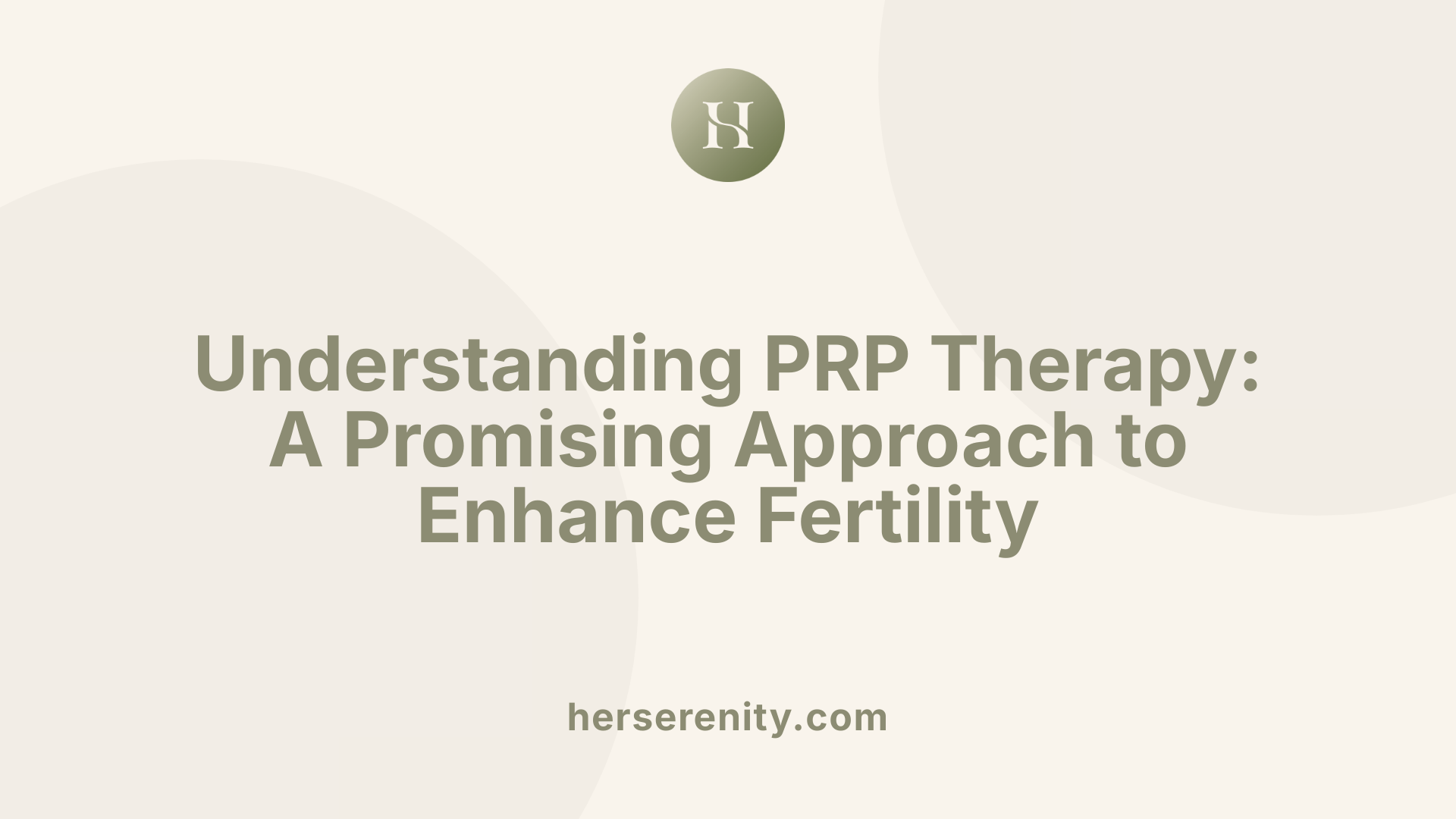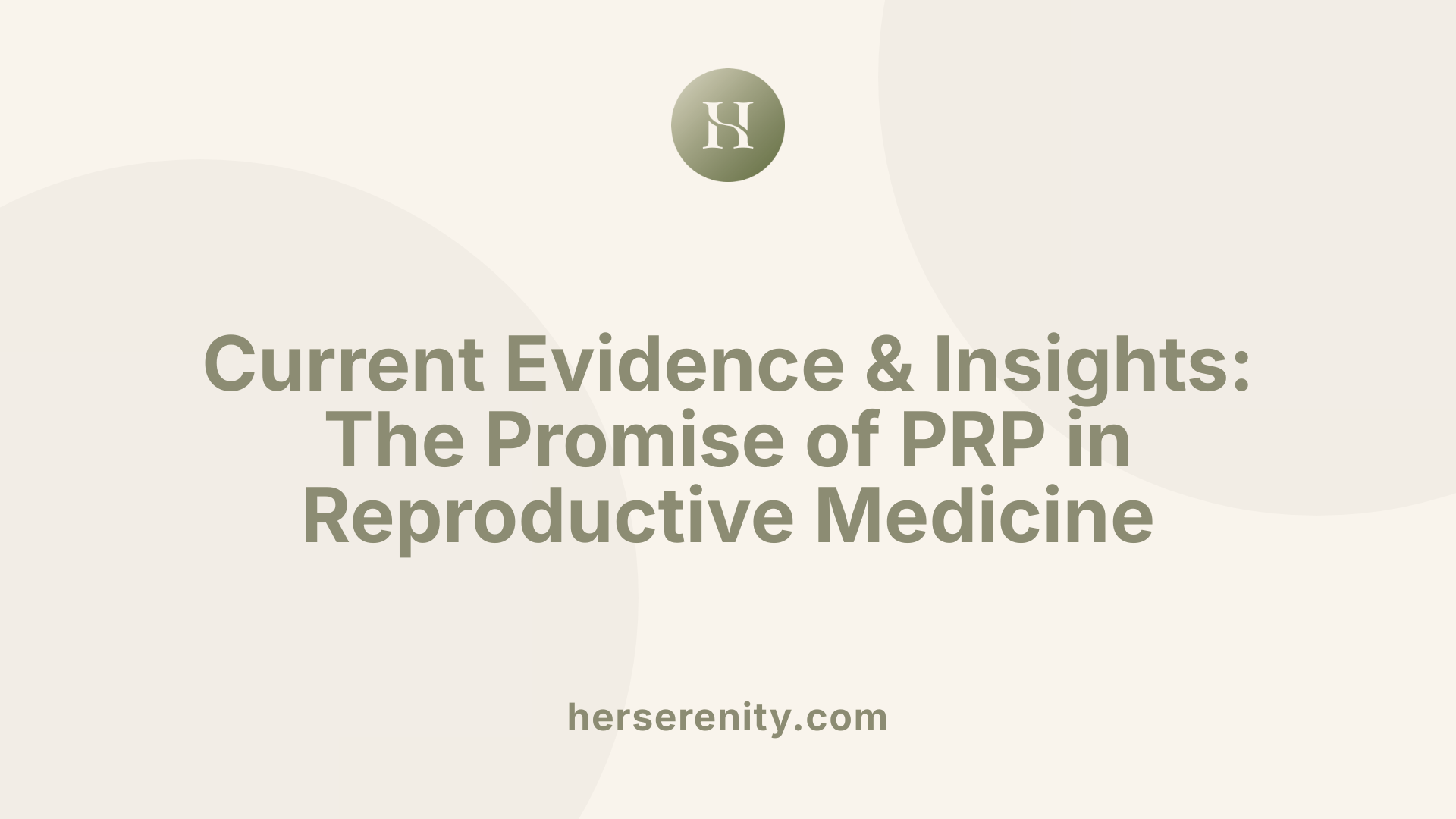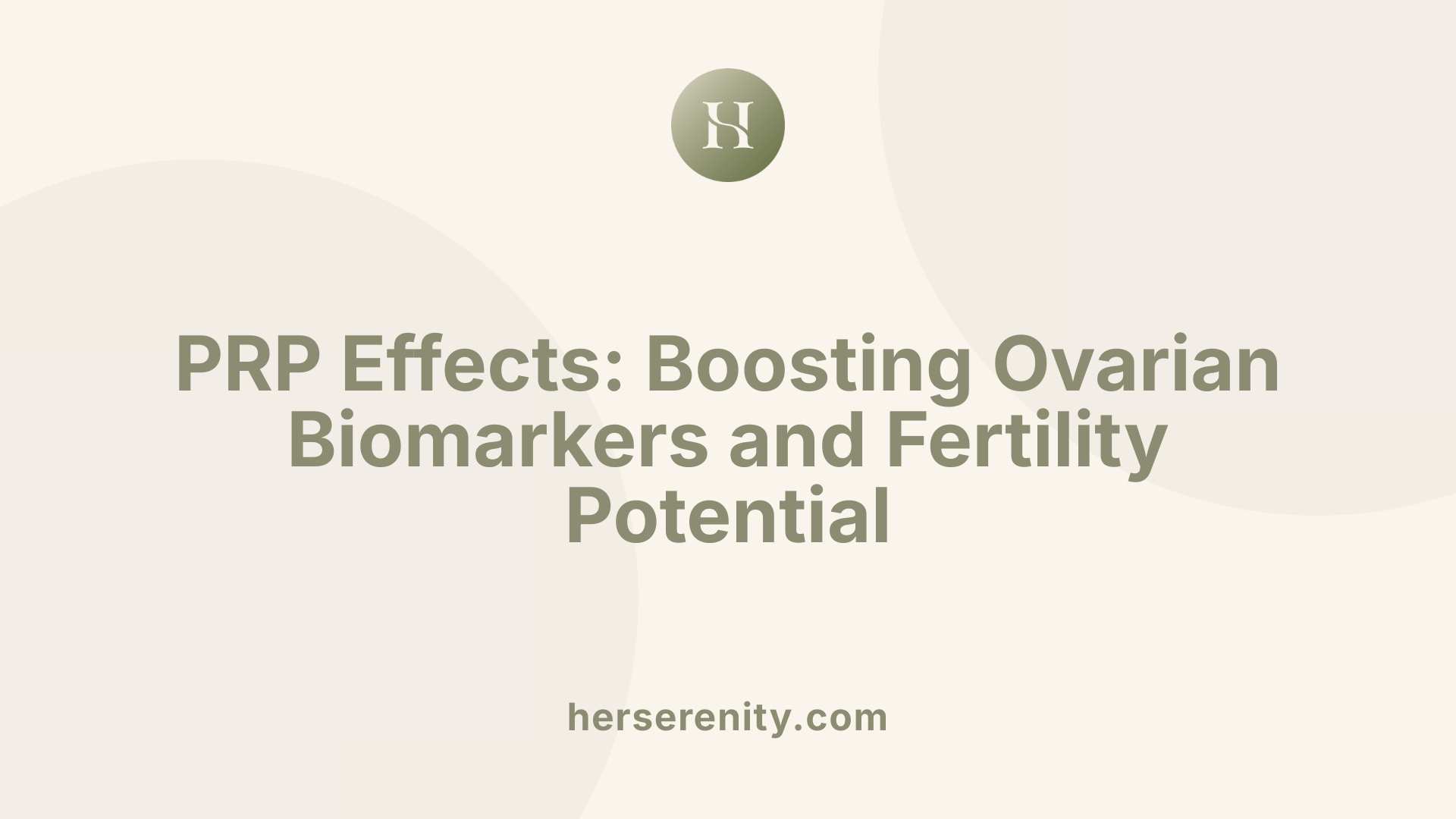Introduction to PRP and ovarian health
Platelet-rich plasma (PRP) therapy has emerged as an innovative approach in reproductive medicine, aiming to rejuvenate ovarian tissue and enhance fertility outcomes. Derived from the patient’s own blood, PRP contains a concentrated mixture of growth factors that support tissue regeneration, angiogenesis, and cellular proliferation. Its application, particularly through intraovarian injections, seeks to improve ovarian reserve, oocyte quality, and hormonal balance, offering hope to women facing diminished ovarian reserve, premature ovarian failure, or other forms of ovarian dysfunction.
What is PRP therapy and its role in ovarian rejuvenation

What is PRP therapy and how can it improve ovarian function and fertility outcomes?
PRP, or platelet-rich plasma, therapy is a procedure that involves collecting a patient’s blood, processing it to concentrate the platelets, and then injecting this enriched plasma directly into the ovaries or uterus.
This approach is especially explored in reproductive medicine for women facing diminished ovarian reserve or premature ovarian failure. The main idea behind PRP therapy is to rejuvenate ovarian tissue by leveraging the regenerative properties of growth factors found in platelets.
The process begins with drawing about 30 mL of blood from the patient, which is then spun in a centrifuge. This separates the blood into different components, isolating the platelet-rich plasma. The resulting PRP contains a concentration of platelets 3 to 5 times higher than normal blood, packed with growth factors like PDGF, VEGF, IGF-1, and others that promote healing and regeneration.
Once prepared, the PRP is injected into the ovaries under ultrasound guidance, either transvaginally or via laparoscopy. The entire procedure typically lasts about 20-30 minutes with minimal discomfort. Post-injection, the aim is to stimulate the ovarian tissue, including possibly activating dormant primordial follicles, improving hormone levels, and increasing follicle count.
How PRP is prepared and administered
Preparation involves drawing blood, processing it with a centrifuge to concentrate platelets, and obtaining the platelet-rich portion. The procedure is performed with the patient under local anesthesia or mild sedation, depending on the method of injection.
Different techniques, including ultrasound-guided intraovarian injections, are used. The frequency and timing of treatments vary, but some protocols administer PRP one or two times, with follow-up assessments typically measuring hormonal levels, ovarian response, and embryo quality.
Potential mechanisms of action in ovarian tissue
PRP's effectiveness is attributed to its rich assortment of growth factors. These factors promote cell proliferation, differentiation, and angiogenesis, which can improve blood supply and tissue health.
Research has also suggested that PRP might activate ovarian stem cells, encouraging the development of new follicles or revitalizing existing ones. The therapy influences pathways involved in cell survival, metabolism, and communication between follicular cells, thereby supporting follicle activation, growth, and oocyte maturation.
Further, PRP may regulate pathways related to apoptosis, helping in the survival of developing eggs and improving their quality.
What do recent studies reveal about PRP in ovarian rejuvenation?
Meta-analyses of 38 studies with 2256 women have reported that PRP treatment significantly increases ovarian reserve markers such as Anti-Müllerian hormone (AMH) levels and antral follicle count (AFC). These physiological changes are associated with improved fertility potential.
Hormonal profiles also show promising shifts post-PRP; notably, FSH levels tend to decrease, indicating enhanced ovarian function. The number of retrieved oocytes and embryos created also increases, leading to higher chances of pregnancy.
In terms of pregnancy outcomes, spontaneous pregnancy rates have been observed around 7%, with some studies reporting live birth rates of about 11%. These outcomes suggest a potential role for PRP in fertility treatments, particularly for women with poor ovarian response.
Safety and current research limitations
PRP is generally considered safe since it is derived from the individual's own blood, minimizing rejection or adverse reactions. No significant complications have been reported.
However, despite these encouraging findings, the evidence base remains limited. Many studies are preliminary, lack control groups, or have small sample sizes. Also, recent high-quality randomized controlled trials have shown mixed results, with some indicating limited or no benefit from PRP.
Thus, while the biological plausibility and early clinical data support PRP's potential, further robust research is essential to establish standardized protocols, determine long-term safety, and confirm its efficacy in improving fertility outcomes. Until then, PRP remains an experimental approach that may benefit some women but requires careful consideration and professional guidance.
Scientific basis and mechanisms of PRP in ovarian health

What are the mechanisms by which PRP therapy can enhance ovarian health?
Platelet-Rich Plasma (PRP) contains a high concentration of growth factors and proteins that play a crucial role in tissue healing and regeneration. When injected into the ovary, PRP releases substances such as Platelet-Derived Growth Factor (PDGF), Vascular Endothelial Growth Factor (VEGF), Transforming Growth Factor-beta (TGF-β), and Insulin-Like Growth Factor 1 (IGF-1). These factors are key to stimulating cellular processes that restore and improve ovarian function.
One of the main actions of PRP is promoting cell proliferation, which leads to increased growth of ovarian tissue and follicle development. The growth factors support the activation of dormant primordial follicles, potentially rejuvenating the ovarian reserve. This activation may involve signaling pathways such as PI3K/Akt and mTOR, which are well-known for regulating cell growth and survival.
In addition, PRP stimulates angiogenesis—the formation of new blood vessels—mainly through VEGF. Improved blood flow ensures better delivery of oxygen and nutrients to the ovarian tissue, enhancing follicle viability and the health of developing oocytes.
Research also suggests that PRP may activate ovarian stem cells. These stem cells have the potential to differentiate into new follicles, thereby increasing the available pool of eggs. This property offers hope for women with premature ovarian failure or diminished ovarian reserve.
The combined effects of tissue regeneration, enhanced blood supply, and activation of dormant follicles result in improved ovarian environment conducive to folliculogenesis and oocyte maturation. These processes may contribute to higher hormone production, better quality eggs, and ultimately, improved fertility outcomes.
Overall, PRP's regenerative properties, driven by its rich growth factor content, support the recovery of ovarian tissue structure and function. While the exact mechanisms are still under investigation, current evidence supports its role in activating and revitalizing ovarian stem cells and follicles, thereby offering a promising approach for women facing fertility challenges due to ovarian aging or damage.
Research evidence supporting PRP for ovarian function enhancement

What scientific evidence and research support the use of PRP therapy for ovarian rejuvenation?
Platelet-rich plasma (PRP) therapy has attracted significant interest in the field of reproductive medicine, mainly because of its potential to improve ovarian function in women with diminished ovarian reserve (DOR). Early studies, including case reports and small observational studies, suggested some promising outcomes. These included increases in Anti-Müllerian hormone (AMH) levels, follicle count, and the number of retrieved eggs, indicating a possible rejuvenation of ovarian tissue.
A comprehensive meta-analysis that included 38 studies with a total of 2256 women lent support to these initial findings. It demonstrated that after PRP treatment, there were statistically significant improvements in serum AMH levels at 1, 2, and 3 months, with the peak increase observed at three months (mean difference [MD] 0.36, p=0.002). Additionally, FSH levels decreased significantly within the same period (MD -10.20, p=0.039 at 1 month). Antral follicle count (AFC) also saw notable increases (MD 1.60, p<0.001), alongside a rise in the number of oocytes retrieved (MD 0.81, p=0.002) and embryos created (MD 0.91, p=0.001). These measures point toward an improvement in ovarian reserve and response.
Regarding reproductive outcomes, the data showed that spontaneous pregnancy occurred in approximately 7% of women following PRP therapy, with biochemical pregnancy rates reaching 18% and live birth rates around 11%. Importantly, no adverse effects or complications linked to PRP injections were reported, indicating a favorable safety profile.
Further molecular research offers insights into how PRP may exert its effects. Studies analyzing cumulus cells from women aged 18 to 37 with poor ovarian response revealed increased activity in genes associated with metabolism, cell survival, and intercellular communication after PRP treatment. This suggests that PRP influences pathways involved in follicular activation, cell proliferation, and oocyte maturation—key processes for improving fertility.
However, more recent high-quality randomized controlled trials (RCTs) published in 2024 have cast some doubt on these initial optimistic findings. One large RCT observed that although there was a slight increase in the number of eggs retrieved, it did not translate into better embryo quality or higher pregnancy rates. Surprisingly, the pregnancy rate was lower in the PRP group (27%) compared to controls (60%). Another well-conducted study found no significant differences in ovarian reserve markers, fertilization, or pregnancy success between women treated with PRP and those who were not.
These more rigorous studies highlight the ongoing debate about the true efficacy of PRP for ovarian rejuvenation. While the biological rationale and early clinical data seem encouraging, current high-quality evidence remains inconclusive. Researchers acknowledge the need for further large-scale, randomized trials to definitively determine whether PRP improves fertility outcomes or if its observed benefits are limited to biochemical and follicular markers.
In conclusion, initial studies supported by meta-analyses suggest that PRP has the potential to enhance ovarian reserve markers and follicular activity. Yet, recent controlled trials question whether these biochemical improvements translate into meaningful reproductive success.
| Evidence Type | Findings | Significance | Additional Notes |
|---|---|---|---|
| Meta-analysis | Improved AMH, AFC, oocyte count | Supports ovarian response enhancement | Based on 38 studies and 2256 women |
| Molecular studies | Increased gene activity related to cell survival and metabolism | Suggests cellular mechanisms of action | Cumulus cell analysis |
| 2024 RCTs | No significant improvement in pregnancy outcomes, some decreased rates | Questions efficacy | Larger, controlled data |
| Safety reports | No significant complications | Confirms overall safety | Consistent across studies |
Research findings on PRP ovarian rejuvenation efficacy continue to evolve. While promising in biological and early clinical parameters, current evidence from randomized trials urges caution and emphasizes the need for further rigorous research.
More information search query: Research findings on PRP ovarian rejuvenation efficacy
Impact of intra-ovarian PRP on ovarian biomarkers and reproductive success

How does intra-ovarian PRP influence key ovarian biomarkers?
Recent research, including a comprehensive meta-analysis of 38 studies involving 2256 women, indicates that intra-ovarian PRP treatment has a significant effect on several important ovarian biomarkers. Notably, levels of Anti-Müllerian hormone (AMH), a marker of ovarian reserve, increased substantially at 1, 2, and 3 months following treatment, with the most pronounced increase observed at three months (mean difference 0.36). This suggests an improvement in the functional capacity of the ovaries.
Simultaneously, levels of Follicle Stimulating Hormone (FSH) decreased significantly within the same time frame (mean difference -10.20), indicating enhanced ovarian responsiveness. The Antral Follicle Count (AFC), which reflects the observable follicle pool via ultrasound, also showed a significant rising trend (mean difference 1.60), bolstering evidence of improved ovarian activity.
What are the effects on oocyte and embryo production?
PRP therapy has been linked with increased ovarian output. Studies report that the number of retrieved oocytes increased significantly post-treatment, with an average rise of around 0.81 oocytes per patient. Furthermore, the number of high-quality embryos created also showed notable enhancement, with an average increase of nearly one embryo per treatment cycle.
This improvement in embryo yield is particularly critical for women undergoing assisted reproductive procedures, as it directly influences the chances of successful pregnancy.
What are the observed pregnancy and birth outcomes?
The reproductive success following intra-ovarian PRP treatment, though modest, is encouraging. Spontaneous pregnancy rates have been reported at approximately 7%. More structured assessments involving IVF patients have demonstrated biochemical pregnancy rates as high as 18%, with live birth rates around 11% in some cases.
While these figures suggest some potential benefit, it is important to interpret them cautiously as the data are drawn from varied studies with different patient profiles.
Summarizing the impact based on current evidence
| Aspect | Findings | Additional Details |
|---|---|---|
| Ovarian biomarkers | AMH ↑, FSH ↓, AFC ↑ | Signifies improved ovarian reserve and response |
| Oocyte & embryo yield | Oocytes ↑ (~0.81), Embryos ↑ (~0.91) | Enhances potential for conception |
| Pregnancy and live birth rates | Pregnancy (~7%), Biochemical (~18%), Live birth (~11%) | Reflect steps closer to successful pregnancy |
Are these improvements consistent and safe?
The promising biomarker changes and increased oocyte and embryo outputs indicate that PRP has regenerative effects on the ovaries. However, these findings are mainly based on smaller studies and observational data, which are subject to biases and variability.
Importantly, no adverse effects related to PRP injections have been reported so far, supporting the treatment’s safety profile. Nonetheless, the need for larger, high-quality randomized controlled trials remains critical to establish definitive efficacy and safety.
What do current studies say about the mechanism?
Animal models and molecular studies reveal that PRP influences genes related to metabolism, cell survival, and communication among cells within the ovarian tissue. It promotes pathways associated with cell proliferation, survival, and angiogenesis, which are vital for follicle activation and oocyte maturation. PRP contains growth factors such as PDGF, VEGF, and IGF-1, which orchestrate tissue rebuilding, blood vessel formation, and cellular growth.
Are there limitations to current evidence?
Despite the encouraging results, current research faces limitations such as small sample sizes, lack of long-term data, and inconsistent outcome measures. Some recent randomized controlled trials have shown conflicting results, with one indicating no significant improvement in pregnancy outcomes and even lower pregnancy rates compared to control groups.
As a result, while intra-ovarian PRP shows regenerative potential, definitive evidence for routine clinical use remains to be established. Future large-scale, well-designed trials are essential to clarify its role in fertility treatment.
Final thoughts
Intra-ovarian PRP therapy demonstrates promising effects on ovarian biomarkers such as increased AMH and AFC, reduced FSH, and improved oocyte and embryo yields. These biological changes underpin its potential to enhance fertility among women with diminished ovarian reserve.
However, current evidence is mixed, and the long-term safety and effectiveness are yet to be confirmed. Careful patient selection and further research are necessary before broader adoption can be recommended.
Current clinical findings and fertility outcomes

What does current evidence say about the effectiveness of PRP as a fertility treatment option?
Recent studies and reviews indicate that platelet-rich plasma (PRP) therapy offers promising potential for women facing reproductive challenges, particularly those with diminished ovarian reserve. Evidence from a comprehensive meta-analysis involving 38 studies with a total of 2256 women reveals significant improvements in various ovarian and fertility parameters following PRP treatment.
One of the most notable findings is the increase in Anti-Müllerian Hormone (AMH) levels, a marker of ovarian reserve, which significantly rose at 1, 2, and 3 months post-treatment. The greatest rise was observed at 3 months, with a mean difference of 0.36. Concurrently, Follicle Stimulating Hormone (FSH) levels decreased significantly, indicating improved ovarian function, with a notable reduction at 1 month.
In addition to hormonal improvements, the antral follicle count (AFC), an ultrasound assessment of ovarian follicles, increased substantially post-PRP, with an average rise of 1.60 follicles. The number of retrieved oocytes during IVF cycles also increased, with a mean increase of 0.81, alongside a rise in the number of usable embryos, which grew by an average of 0.91.
Fertility outcomes have also shown some encouraging results. The spontaneous pregnancy rate after PRP therapy is approximately 7%. While modest, this suggests potential for natural conception post-treatment. Clinical pregnancy rates, defined by biochemical confirmation, reached about 18%, and live birth rates were around 11%.
Moreover, the safety profile of PRP appears favorable, as no treatment-related complications have been reported in the included studies. This safety, combined with observed improvements, suggests that PRP therapy can positively influence ovarian function and reproductive outcomes.
However, the current evidence has limitations. Many studies are preliminary, with small sample sizes and varied methodologies. Recent high-quality randomized controlled trials (RCTs) have produced mixed results. For instance, two 2024 RCTs did not find significant improvements in IVF outcomes or pregnancy rates, and one observed a lower pregnancy rate in the PRP group compared to controls.
Therefore, although current data is promising, the definitive efficacy of PRP remains uncertain. More large-scale, standardized, randomized studies are essential to confirm these benefits and to develop clear guidelines for clinical use.
| Parameter | Findings | Significance | Implications |
|---|---|---|---|
| AMH levels | Increase (MD 0.36) at 3 months | p=0.002 | Indicates improved ovarian reserve |
| FSH levels | Decrease (MD -10.20) at 1 month | p=0.039 | Suggests better ovarian function |
| Antral follicle count | Increase (MD 1.60) | p<0.001 | Reflects increased follicular activity |
| Oocytes retrieved | Increase (MD 0.81) | p=0.002 | Higher potential for fertilization |
| Embryos created | Increase (MD 0.91) | p=0.001 | Possible improvement in embryo quality |
| Pregnancy rate (spont) | ~7% | Limited but positive impact on natural conception | |
| Biochemical pregnancy | 18% | Shows potential for spontaneous and assisted pregnancies | |
| Live birth rate | 11% | Encouraging, but requires further confirmation |
Effectiveness and limitations of current evidence
While the data points to potential benefits, the overall confidence in PRP's efficacy as a fertility treatment remains cautious. Many studies are observational or involve small patient cohorts. Recent high-quality RCTs have questioned some of the earlier optimistic findings, highlighting that PRP might not consistently improve embryo quality or pregnancy rates.
In conclusion, PRP's role in fertility treatment is still experimental. It appears safe and beneficial in some cases, especially for ovarian rejuvenation, but the variability in study results underscores the necessity for further research. Larger, well-designed clinical trials are crucial before PRP can be considered a standard treatment option.
| Aspect | Current Evidence | Need for Further Research | Comments |
|---|---|---|---|
| Hormonal improvements | Promising but inconsistent across studies | Yes, large RCTs required | Confirm effects on AMH, FSH, LH levels |
| Follicle count | Generally increased, but not in all cases | Yes, standardization needed | Determine patient profiles most likely to benefit |
| Pregnancy outcomes | Mixed results; some show modest gains, others do not | Yes, larger trials to clarify efficacy | Need to understand patient selection criteria |
| Safety profile | Favorable; no serious adverse effects reported | No, safety remains assured | Further long-term safety studies recommended |
Overall, while PRP therapy demonstrates some benefits, its routine use in fertility treatments remains unproven, emphasizing the importance of ongoing and future high-quality investigations.
Safety profile and future outlook of PRP therapy in reproductive medicine
What is the process, potential benefits, risks, and scientific basis of PRP therapy in reproductive medicine?
PRP (platelet-rich plasma) therapy involves a straightforward process where a patient's own blood is drawn and then centrifuged to isolate the platelet-rich component. This concentrated plasma, packed with growth factors such as PDGF, VEGF, and IGF, is then injected into ovaries or uterine tissue. The goal is to stimulate tissue regeneration, improve blood supply, and activate dormant follicles or enhance the endometrial lining.
The scientific rationale behind PRP therapy lies in its regenerative properties. Growth factors in PRP promote cellular proliferation, stimulate angiogenesis (new blood vessel formation), and support tissue repair. This makes PRP a promising tool for rejuvenating ovarian tissue and improving endometrial receptivity, particularly in women with diminished ovarian reserve or recurrent implantation failure.
Among the potential benefits reported are increases in anti-Müllerian hormone (AMH) levels—a marker of ovarian reserve, increased antral follicle count (AFC), and improvements in hormone profiles such as decreased FSH levels. Some women have experienced increased oocyte yields during IVF cycles, higher embryo quality, and successful pregnancies post-treatment.
Despite these promising outcomes, PRP therapy generally presents a minimal risk profile. Since the treatment uses autologous blood, the risk of rejection or allergic reactions is negligible. Minor adverse effects reported include local bleeding, bruising, tenderness, swelling, or dizziness, but no serious complications have been documented. The procedure is considered safe, rapid (about 20-30 minutes), and is usually done under ultrasound guidance.
However, it's essential to acknowledge the gaps in current knowledge. High-quality, large-scale randomized controlled trials are still limited, and different studies have shown inconsistent results regarding its effectiveness. Some recent research indicates that PRP may not significantly enhance fertility outcomes or improve ovarian response in all populations. Variability in preparation methods, injection protocols, and patient selection complicates the interpretation of results.
Risks and adverse effects
The overall safety profile of PRP is excellent, with no significant adverse effects reported in current literature. The primary risks are related to the injection procedure itself—such as infection, bleeding, or discomfort at the injection site. Because PRP is derived from the patient's own blood, allergic reactions or rejection are virtually nonexistent.
A few studies have raised concerns about the inconsistent results where some women did not experience benefits. Additionally, the lack of standardized protocols makes it challenging to predict outcomes or optimize treatment strategies. There is also a theoretical possibility that PRP could stimulate unwanted tissue growth or fibrosis if improperly administered, though such adverse effects have not been documented.
Need for further research and standardization
Given the current evidence, further investigation is crucial. Large randomized controlled trials are needed to validate initial promising results, establish optimal treatment protocols, and evaluate long-term safety.
Standardization in PRP preparation—such as platelet concentration, activation methods, and injection frequency—is essential to facilitate comparability across clinical studies. Moreover, identifying which patient populations are most likely to benefit can help personalize therapy.
In conclusion, while PRP therapy appears safe with potential fertility-enhancing effects, the scientific community must conduct more rigorous research. Only through high-quality trials can reproductive medicine confidently incorporate PRP as a mainstream treatment for ovarian and endometrial rejuvenation.
| Aspect | Details | Further Comments |
|---|---|---|
| Procedure | Blood draw, centrifuge, autologous PRP injection | Done via ultrasound or laparoscopy |
| Benefits | Increases ovarian reserve markers, improves embryo quality, enhances endometrial thickness | Variable outcomes reported |
| Risks | Minor: bleeding, infection, swelling | No serious adverse effects documented |
| Research needs | Standardized protocols, large trials, patient selection | Essential for validation |
| Overall safety | Excellent | Minimal risks involved |
Research continues to evolve, but PRP holds promise for women facing fertility challenges due to ovarian aging or damage. Pending further evidence, it remains a hopeful yet experimental option in reproductive medicine.
Conclusion: The Future of PRP in Fertility Treatments
PRP therapy presents a promising frontier in reproductive medicine, with potential to rejuvenate ovarian tissue, improve hormonal profiles, and enhance fertility outcomes. Although initial results are encouraging, particularly for women with diminished ovarian reserve or premature ovarian failure, high-quality large-scale studies are needed to establish standardized protocols, confirm long-term safety, and determine optimal treatment timing and frequency. As research evolves, PRP could become a valuable addition to the toolkit for fertility specialists, offering hope to many women seeking to conceive amidst challenging reproductive circumstances.
References
- Platelet-rich plasma (PRP) treatment of the ovaries significantly ...
- Platelet-Rich Plasma May Support Ovarian Function in Women with ...
- Enhancement of Ovarian Reserve and Oocyte Quality After Platelet ...
- Intraovarian platelet-rich plasma injection significantly improves ...
- Ovarian PRP with Dr. Aimee
- Ovarian PRP — W.H.M - Women's Health Melbourne
- Therapeutic roles of platelet-rich plasma to restore female ... - Frontiers
- PRP Ovarian Rejuvenation Q & A - Gen 5 Fertility Center
- Evaluation of intraovarian injection of platelet-rich plasma for ...
- Platelet-Rich Plasma Therapy (PRP) in Chicago, IL





